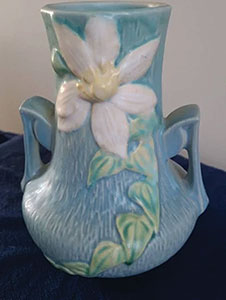The Vase and its Long Connection to Home Decoration
Opinion Advocates for ideas and draws conclusions based on the author/producer’s interpretation of facts and data.

By Bill Primavera
Among my possessions, I have only one family heirloom. It is a 1940s vase made in the town of Roseville, Ohio and is, in fact, called Roseville.
It was given to my parents by my Aunt Helen, the artist on my father’s side of the family, and may have been one of the few art pieces in our home. My parents decorated their home rather simply with the living room having just the basics of a sofa, side chairs and a large mirror in a gold frame. But that vase was our one concession to something “arty.”
Vases have been a popular decorative object throughout history and across many different cultures and time periods.
Those of ancient civilizations, including the Egyptians, Greeks and Romans, vases were primarily used for practical purposes, such as holding water or oil. These vases were often made of clay or metal and were decorated with intricate patterns and designs that reflected the culture and beliefs of the society.
For example, the ancient Egyptians decorated vases with hieroglyphs and images of gods and pharaohs, while the ancient Greeks used vases to hold wine and decorated them with scenes from myths and legends.
In the Middle Ages, vases were primarily used for religious purposes, such as holding holy water or oil. These vases were often made of metal or glass and were decorated with intricate patterns and designs that reflected the religious beliefs of the society.
Vases from the Gothic period were often contained images of angels and saints, while those from the Romanesque period had geometric patterns and abstract designs.
During the Renaissance, vases began to be used more for decorative purposes, rather than practical ones. The vases of this period were often made of porcelain or glass and had intricate patterns and designs that reflected the artistic and cultural ideals of the society. Vases from the Italian Renaissance, for instance, often contained images of mythological creatures and scenes from classical literature, while those from the French Renaissance were decorated with ornate floral patterns and designs.
In the Baroque period, vases were often used as status symbols and had ornate patterns and designs that reflected the opulent and grandiose style of the era. Vases were often made of porcelain or metal and were adorned with intricate carvings, gilding and enamelwork. In this period in Europe, the vases often featured elaborate floral patterns and designs, while those from Asia were decorated with intricate landscapes and scenes from nature.
During the 18th and 19th centuries, vases were primarily used for decorative purposes, and were often used to enhance the homes of the wealthy. Vases from this period were typically made of porcelain, glass or metal and were decorated with intricate patterns and designs that reflected the artistic and cultural ideals of the society.
Vases from the 18th century in Europe often had ornate floral patterns and designs, while those from the 19th century in America could often be seen with images of nature and scenes from everyday life.
In the 20th century, vases continued to be used for decorative purposes, and were most often found in the homes of the wealthy. Vases from this period were often made of glass, metal or ceramics and had modern and abstract designs.
The vases of the Art Nouveau and Art Deco movements were often decorated with intricate patterns and designs, while those from the Bauhaus movement (1919 to 1933, combining crafts and the fine arts) had minimalistic designs.
Vases have been a popular decorative object throughout history, and across many different cultures and time periods, right up to today. How nice it is to combine the beauty of flowers with the fine art found in beautiful vases.
Bill Primavera is a realtor associated with William Raveis Real Estate and founder of Primavera Public Relations, Inc., specializing in lifestyles, real estate and development. To engage the services of The Home Guru and his team to market your home for sale, call 914-522-2076.

Examiner Media – Keeping you informed with professionally-reported local news, features, and sports coverage.
